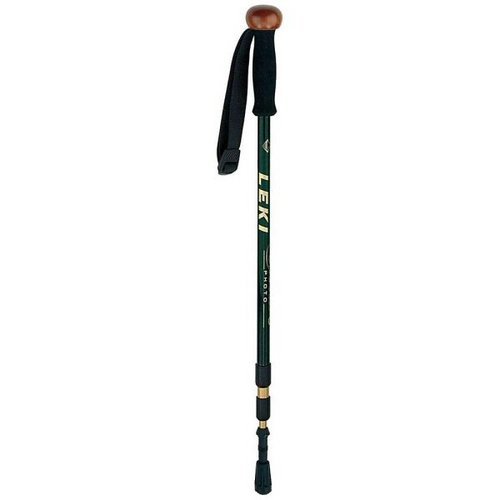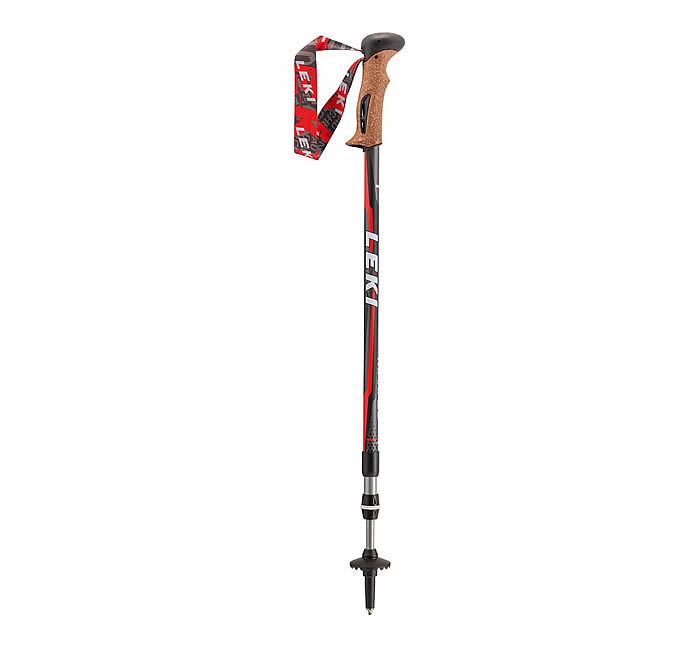I enjoy breaking my leg or twisting an ankle when out hiking. Don't you?
Well, if you don't, then I suggest consider investing in something that is aghast to many hikers—a trekking pole, also known as a hiking staff.
 |
| A Leki Anti-Shock Trekking Pole With "Round Head" from Amazon. |
A hiking staff or trekking pole is, to many hikers (including me), an indispensable piece of equipment. Some hikers think trekking poles are just an irritation and yet another item to lug around (or as one old Montana hiker put it, something yuppies use), even though they've never used them before. Whether a hiking staff or a trekking pole is an irritation or a benefit depends on your personality and what types of hiking you enjoy doing.
Yet, I’ve found a trekking pole is indispensable for all but the shortest or flattest hikes. While I left my hiking staff in the when hiking the Ice Age Trail in Wisconsin, I always use it when hiking a mountain trail in Montana or the Sierras.
This article covers the following topics:
The Many Benefits of a Trekking Pole
When it comes to trekking poles, I’ve found one common trait among people who don’t use them—they can’t overcome the “stigma.” For some odd reason, many hikers equate using a trekking pole to being old, feeble or an arrogant yuppie.
Yet, if a hiker can overcome that stigma, they’ll discover a large array of benefits that a pole provides. These benefits include:
- Pacing - There is no better way to pace yourself, especially when climbing uphill, than with a trekking pole. A trekking pole will easily allow you to set and maintain a steady, non-exhausting pace. As a result, I've found I can cover greater distances and am less tired because of a steady hiking pace.
- River Crossings - Ever crossed a river carrying a backpack on slippery rocks or over fallen logs? It's a dicey situation, especially while wearing a heavy pack. A trekking pole, in these types of situations, acts as a "third leg,” allowing for much improved balance.
- Off Trail - When heading off trail, a trekking pole or hiking staff always comes in handy. When hiking off trail, hikers often have to climb over downed timber, traverse rock gardens and pound through dense brush. By using a trekking pole, a hiker will have better balance when they encounter these off-trail hazards. And better balance equates to a far less likelihood of visiting a local Montana hospital.
- Safety - A hiking staff acts as a third leg and helps maintain balance over on-trail and off-trail obstacles. I can say that my own Leki Trekking Pole has prevented many fall-downs, sprained ankles and one potentially sprained knee. A trekking pole, due to the better balance it provides the hiker, reduces the possibilities of injuries due to falls, bad steps and sometimes bad judgment.
- Reducing Weight on the Feet – Trekking poles are light, but still weigh something. However, the small extra weight gained by carrying a pole is offset by the reduction in weight on your feet and legs. It is estimated that a hiking staff reduces the load on a hikers' feet by 15%. This happens because part of the hiker’s weight is transferred to the trekking pole instead of their feet. When going steeply uphill, this percentage rises even further. In short, using a trekking pole adds a few ounces in total weight to a hiking outfit but reduces the load carried on the feet. This helps reduce foot soreness and fatigue on longer hikes.
The Two Styles of Trekking Poles
The two major types of trekking poles differ in how the top (or handle) of the pole is designed. For simplicity, I label these different types of hiking staffs as the “Ski Pole Style” and the “Top Ball Style.”
The Top Ball Style
A “Top Ball Style,” whichI onced preferred, has a rounded ball on the pole’s top. Attached to the pole just below the top is a rounded wrist loop. And where the hand grips the pole a generous amount of padding is provided (usually soft form, but more recent poles now have cork handles). With a “Top Ball Style” of hiking staff, a hiker can use the pole two different ways. They can rest their hand on the top ball or insert their hand into the wrist loop and grip the pole just beneath the rounded ball.
Also, while I never use it, the ball on most "round ball" trekking poles screws off. Beneath the ball is a mount for cameras, allowing the trekking pole to function as a monopod.
The advantage of the “Top Ball Style” was quite stark compared to older versions of "Ski Pole Style" poles, as the provided much better balance for walking downhill. However, the newer "Ski Pole Style" poles almost always have much larger handles compared to the poles made years ago, thus removing this advantage.
The "Ski Pole Style"
By contrast, a “Ski Pole Style” top resembles a handle found on downhill skiing poles - with a clearly defined handle grip and a wrist loop strap.
 |
| A Leki Anti-Shock, Cork "Ski Pole Style" Trekking Pole. View more Leki Anti-Shock Poles at Amazon. |
Years ago, most ski pole style trekking poles were difficult to use for steep downhill descents. The reason for this was because the top of the pole also resembled a ski pole - the top of the pole was far too small to rest and balance a hand on top. The inability to keep a hand on top of the pole made steep descents difficult, since hikers often had to squat or maneuver into awkward stances to balance on the pole.
Today, however, the newer poles (well, at least the good ones) all have larger handles that make it simple to grip the pole from the top.
Typically, hikers who use “Ski Pole Style” hiking staffs use two of them—one for each hand.
For uphill climbs, “Ski Pole Style” hiking staffs are superior to “Top Ball Style” staffs—especially when two poles are used. By using two poles, a hiker reduces the stress on their legs substantially. Moreover, for uphill climbs, the grips on “Ski Pole Style” hiking staffs provide more power.
Which Style to Choose?
The old versions of “Ski Pole Style” hiking staffs were awkward and sometimes even dangerous to use on dowhill climbs, especially on steeper slopes. Since they weren't designed to be gripped from the top, the hiker often needed to squat and reach forward to use them—which isn’t a desirable position to be in when walking down steeper slopes. Additionally, significant strain was put on the hand and wrist during downhill climbs using the “Ski Pole Style.”
Today, however, quality ski pole style poles no longer have this problem. As such, I now recommend ski pole style poles because they provide the same balance going downhill as a top ball style pole, while providing much more power for uphill climbs.
But ultimately, the choice of a trekking pole is as much a personal choice as anything. There is no "one right" answer as to which style to use.
Trekking Pole Shopping Considerations
While not the fanciest pieces of equipment, there's still a number of considerations anyone shopping for a trekking pole should consider.
Length & Weight Considerations
Most hiking staffs are either collapsible or foldable, and allow ample adjustments to meet the hiker’s needs. However, some poles, even when fully collapsed or folded, are still rather long—sometimes exceeding three feet long. Better trekking poles typically collapse/fold down to around two feet long. For traveling, a fully collapsible or foldable hiking staff makes it simple to stuff it in a suitcase or small daypack.
Then there’s the weight of the hiking staff. To put it simply, always buy the lightest pole. Remember, one of the big benefits of a trekking pole is the ability to transfer weight off the feet—especially on uphill or downhill climbs. By carrying a heavy hiking staff, the hiker reduces this large benefit. On longer hikes, those extra ounces start to feel like many pounds as the day wears on.
Anti-Shock Feature
One high-tech feature of quality hiking poles is “anti-shock.” Anti-shock hiking staff’s have internal suspension systems which reduce the jarring hit that happens when the hiker plants the pole in the ground.
While I was skeptical about anti-shock poles at first, after the first mile of using my Leki Anti-Shock Pole I became a full convert. The anti-shock feature of a hiking staff reduces stress on the hand and wrist. In general, an anti-shock hiking pole makes it much more comfortable to use a hiking staff on longer hikes.
While anti-shock trekking poles cost about $20 or so more than poles that lack anti-shock, the extra money spent is well worth it. After using an anti-shock pole, a hiker will wonder how in the world they hiked without one.
Weight
For day hiking, the weight of a trekking pole is fairly immaterial. However, for backpacking - especially if the hiker plans to use two poles - a poles weight is crucial. Rather obviously, for backpackers the rule is : Lighter is Better. Thus, if you plan to backpack (or just think you might), then get a pole with the lightest weight and most portabiity.
Grip Type
Many trekking poles, particularly those costing less than $100, use a comfortable black foam for the grip. The foam is soft on the hand and, in all the time I've used them, never once had a blister form or have discomfort in my hand.
However, there is one problem. Many poles that use black foam on the handles have a tendency to "transfer that foam" from the pole to the hand over the course of a long hike, especially during hot weather. As such, it isn't uncommon for a hiker to have "black hands" by day's end.
For this reason, cork is now often used on higher end trekking poles. Additionally, cork handles often are less slippery than foam handles (although much depends on the type of foam used). Finally, for ultralight backpackers, the use of cork shaves an ounce or two off a trekking poless weight.
Suggested Trekking Pole & Where to Buy It
Offline, many outdoor retailers that sell technical gear—particularly REI—sell a nice selection of trekking poles. However, at REI stores (compared to their website) I’ve found the selection of poles often lacking. In particular, I’ve had a difficult time locating the “round ball type” of trekking poles at REI retail stores.
Online, Amazon has by far the largest selection of trekking poles available. Amazon should definitely be the first-stop when shopping online for a trekking pole.
Browse Selection of Trekking Poles at Amazon
For those who want a suggestion, go with Leki Anti-Shock Trekking Poles. Anti-shock poles are a true gift on any hike. Leki anti-shock poles are available with both round heads and ski pole style heads, and with either foam or ultralight cork handles.
View all Leki Anti-Shock Trekking Poles at Amazon
Other online retailers that have a good selection of quality trekking poles, including those from Black Diamond, include:
